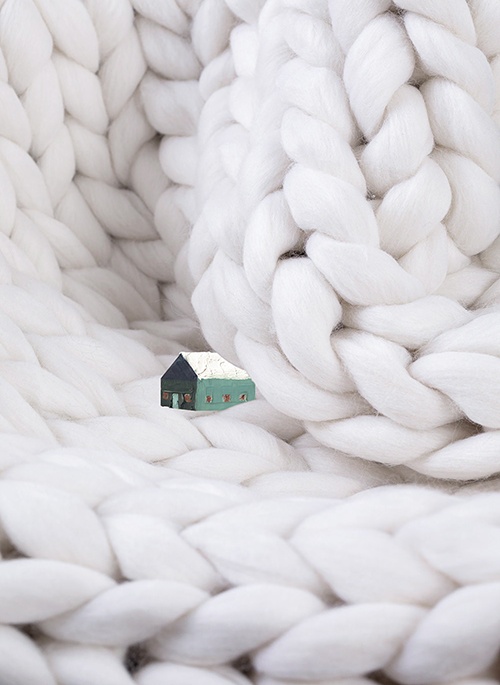 Image by Nancy Pavan, background courtesy of CupOfTea
Image by Nancy Pavan, background courtesy of CupOfTea
Doyennes of the Common Thread
Translation by Katia Grubisic.
Every morning, no matter how hard it might be snowing, if it’s pouring rain or sweltering or if it’s a perfect, equanimous day, I settle in by my office window looking out at a slice of sea, and on my circular needles, or with cheap German fountain pens, I shape loops and links. Whether with wool or with a narrative thread, I can weave a whole idea. Knitting, like writing, is a handcraft.
Material & instructions
Yarn: sport weight or DK
Quantity: 600–800 m
Needles: US 7
Approximate measurements after blocking: 41 cm x 152 cm
Do you like winter? I’m over it as soon as Christmas is done. I’m cold, just waiting for the coming of spring like it’s the Messiah. Back when I was learning to count on my fingers, I could spend hours building a whole settlement of snow forts, blissful in the freezing cold with my shovel, in a balaclava, mittens and snow pants, but my love affair with winter has unravelled over time. The cold has teeth, frigid gales rattle wooden houses, it gets dark at three o’clock in the afternoon, and the power is always going out. The damp seeps deep into the body, and the snow, which can pile up to six feet high in the Gaspé, where I live, melts into boots and soaks through socks. Winter is beautiful, but when the low sky vanishes into the snowy fields, that’s too much white for me. The cold makes me curl into myself.
I spent my first winter in the Gaspésie huddled by a Scandinavian wood stove. We were stingy with the firewood, trying to conserve what little we’d been able to forage in the area. We’d bought the place for a song—this house on the side of a hill, built in 1850, in a village where the baie des Chaleurs folds into the Gulf of Saint Lawrence. It’s a beautiful historic house, rundown, poorly insulated, drafty and facing the wind. Like most falling-down buildings of a certain vintage, it has a name, too, which elevates it to the rank of wise old man.
That winter, the Millar house was puffing non-stop. We were heating the outdoors; we still are. Most of the heat loss was from the summer kitchen, which we should really take down one of these days, before the squirrels move in for good. In the snow that had accumulated in front of the house, my partner dug a trench, several metres long, between the porch and the car. We would snowshoe out to pick up the mail. Does hid in the woods with their fawns. When the wind really let loose, the house went dark for hours. Every storm, the lilac tree would lose a branch or two.
Nine hundred kilometres from Montreal but 750 steps from the sea, far from almost everything in this ramshackle house, stunning in its decline, which became our permanent home because it didn’t cost much, we kept warm with what we had: long johns, two sweaters under puffer jackets—inside the house!—and gloves with the fingers cut off, so we could write. We drank hot tea, wore wool socks to bed and nestled under two duvets with the cat at our feet or on top of us. We spooned. We tracked down warm spots, and tried to create them as best we could. When spring came it was a kind of deliverance. That summer floated by, and by the following fall we knew what to expect and were better prepared to face another winter.
Trouble was, we didn’t know anyone out here. One January morning, my beloved told me that if we wanted to stay healthy, to stay sane during the months of cold, we had to get out and see people now and again. So we snowshoed out to the trailhead at the edge of the woods east of the village. It was nice out, about zero degrees. I was wearing a cable-knit headband I’d made from soft yarn, merino with a bit of cashmere. On the path, a woman behind me quickened her pace and came up on my right. In a clearing, before starting up a hill that to me looked as high as Mount Albert, she turned around, glanced at my headband, and asked if I knitted. “I do,” I replied, “but I mainly do other things.”
Knitting for me was a writing coach, a mood stabilizer and a mental workout. I had discovered it the previous year, at the start of the summer. It had cheered me up while I was reworking the structure of a novel. When I lived in Montreal, I used to go for walks or listen to music to get my imagination going, but in the Gaspé, walking in the woods or by the water emptied my head completely. Any inner monologue here is wiped away by nature—by the beauty, the trees’ stately canopy, the power of the water and the spectacular, mineral tract of the shoreline, which is pretty rugged in my neck of the woods, even in early winter. Over time, I’d built up a satisfying daily routine, and a productive life. My city walks were replaced by textile arts.
“We have a knitting group at the cafe in Chandler,” the woman went on. “You should come. It’s on Tuesday evenings.”
I’m a bit of a loner. I need solitude to write, and since my teenage years I’ve been suspicious of cliques and clubs, of better-thans. But I also know that seeing other people at regular intervals is like turning on the heat or stoking the wood stove when it gets cold.
I waited a week.
When I pushed open the door of the little cafe overlooking the bay, I discovered a new source of warmth: the solidarity of knitters. As I worked on a shawl in bluefaced Leicester and asparagus-green Masham, we talked about the Channel Islands, about needle lace; about Algeria, where Yasmine was born; about Spain, where another woman’s mother lived; about literature, seed potatoes, and gynaecological issues. For four weeks, every Tuesday, out of the cold, I wove connections.
Then the whole world came to a standstill.
When Covid-19 closed the borders of the country, and the province, and then locked me down even on my own land, I escaped the same way everybody else did: into books, movies and TV series, and into knitting. I stepped into the intimacy of a writing project by exploring different times and places where people wore shawls—like Sontag shawls, those long, knitted garments worn crossed over the chest and tied behind the waist or in front—without ever setting foot outside my house.
If I felt like getting on a plane, I’d knit myself a trip: an Icelandic sweater, a colourful Shetland lace shawl, jacquard mittens, socks in yarn as thick and strong as anything from centuries past, a beret. As I waited for the borders to reopen, I honed my needlework, and I learned a new language.
Abbreviations
k: knit
p: purl
yo: yarn over
ssk: slip, slip, knit
s1 k2tg pssto: slip one, knit two together, pass slipped stitch over
Stockinette stitch: row 1: k to end; row 2: p to end
Rice stitch: row 1: k1, p1 to end; row 2: p1, k1 to end
Dandelion stitch: see Super Stitches Knitting
by Karen Hemingway, Potter Craft, 2014
I had never even thought about knitting until June 2019. It was early summer, around the Saint-Jean-Baptiste. After the first winter in the Millar house, traumatized by the brutal cold and the lack of firewood, I was dreaming of a hot, dry summer tempered by the free air conditioning of an ocean breeze I hoped would blow up the hill all the way to us. Before the solstice, I saw a picture on Instagram of a wide, cozy turquoise lace shawl. I had to have it. I wanted it around my shoulders, around my neck, on my lap. Some quick online detective work answered the questions that were distracting me that day from the essentials—writing, reading, doing the dishes.
Who had posted the picture of the shawl? A Montreal designer who sometimes taught sewing. Where could I buy one? Nowhere; this was DIY. Where could one buy knitting patterns? On Ravelry. What the hell was Ravelry? A social network for textile artists, especially knitters.
The algorithm clearly knew me better than I knew myself. I got sucked in. After a month of watching YouTube videos, figuring things out by trial and error, swearing like a sailor, struggling with skeins before finding out you were supposed to wind your yarn into a ball first, and pricking my right index finger a hundred times with the sharp tip of a ChiaoGoo red lace needle, I had learned to knit. By the end of the summer, I had my own version of the shawl I’d fallen in love with, knitted myself with no help from anyone, in aran weight purple merino.
I followed that up with a cardigan in country tweed wool, treated with lanolin so it would hold up against just about anything. Then another shawl, quickly, finer this time, in parma wool hand-dyed in Northern Ireland by a girl named Emma using flowers, table scraps and plants.
Down the rabbit hole I went. In this woolly wonderland, I wanted all the accessories and yarns my virtual girlfriends in the United States, Canada, France, Ireland, England, Scotland, Sweden, Norway, Germany, Denmark, and Quebec raved about on their YouTube channels. The knitting group in Chandler was replaced by online wool and fibre geeks, with whom I discovered endless lengths of yarn, first superwash or washable wool, then luxury fibres like merino, cashmere, alpaca, silk and mohair, and finally natural, untreated yarns, rustic wools that brought me as close as possible to what my ancestors would have worked with when they knitted everything knittable back in the day. I was obsessed with textile arts, knitting accessories, fibre and material culture, and with the gradual mastery of a new language: the codes of knitting patterns, sometimes in Frenglish, though most often in English only. Knitting changed my daily routine, and it shifted the thrum behind my inspiration, which has always been about movement.
Since I’ve started knitting, I’ve made an average of one complex piece or two simple accessories each month. There’s always a work-in-progress on my needles. Most of the winter clothes I now wear I knitted myself: socks, scarves, collars, shawls, sweaters, cardigans, mittens, headbands, toques, berets and the fingerless gloves I wear to write in my office from November to April. When my cat died, I wrapped him in the honey-yellow-and-purple Australian merino blanket I’d made him so the wicker basket he loved so much would be couch-comfy. I would never have let Gustave be buried naked, in just the biodegradable sheath the vet gave us after putting him down. The blanket I had knitted for him became a shroud, forty hours of work swathing him in love.
When my mother was pregnant with me, she knitted a coat for herself; but her favourite textile art is loom-weaving, which she learned from the Cercle de fermières women’s group in the church basement of the village where she was born at the edge of the baie des Chaleurs. I don’t know if I ever saw her knit; if I did, I don’t remember, although she claims she tried to pass on the basics of that ancestral art while I was busy playing Nintendo. I’ve never seen my mother’s mother knit, spin or weave either, but my father recently told me that his mother, who died when I was four, knitted every day as a matter of course, the way you cook dinner. I come from a line of knitters, everyday artists, doyennes of the common thread.
With the pen or the needle, I work a thread that has passed through the hands of all those women who once knitted, spun, or wove because they had to: the Scottish women whose men—fathers, husbands, sons—built the Millar house in 1850; the Jersey islanders who took over the spot just before World War I; my Leblancs (LeBlanc with a capital B, before the 1950s), Doyles, Healys, and Firths, who knitted warm socks in Grand-Pré in Acadian Nova Scotia, near Saint-Jacques-de-Leeds in what used to be part of the Bois-Francs region, in Ireland, or in the Gaspé Peninsula; my Lapointes from Montreal and Château-Richer—all women who kept knitting even while they saw to it that life unfolded as it should. Knitting shortens the span between me and all those old girls. And it rasps out a bit of warmth to ward off the cold.
Notes
Cast on 80 sts
Rows 1–8: rice st
Rows 9–13: rice st six times, stockinette st to 6 sts from end, rice st to end of row
Row 14 (braid): rice st six times, Latvian braid to 6 sts from end, rice st to end of row
Row 15: rice st six times, stockinette st to 6 sts from end, rice st to end of row
Row 16 to 1 inch before desired length, ending with wrong-side row: rice st six times, dandelion st* to 6 sts from end, rice st to end of row
7 rows: rice st six times, stockinette st to 6 sts from end, rice st to end of row
Last 8 rows: rice st
*Add shamrock where desired
Knitting is freedom, too: I can travel anywhere I want. With my circular needles, some wool, and a pattern or an idea for a pattern, I tune in to any aesthetic frequency I want—to centuries past, as a gesture to those old girls of mine or their ancestors; to my writing, which most of the time has nothing to do with knitting; or to what lies ahead, which anyone who likes to walk can anticipate, as a blurry, tremulous feeling. If the whole world should one day collapse, I know how to unmake my woolly clothes, which will be of no use to me then, to knit myself some armour.
Saoirse is a girl’s name, an Irish word that means “freedom.” Saoirse was the working title of my third novel, Gens du Nord, set in the early nineties during the Troubles, a book about love, war and spies. When I decided to design my own knitting pattern, I named it Saoirse. I made two versions before I started trying to create the actual pattern, which, inevitably, was imperfect. For the time being, what it looks like is these fragments embedded in the text you’re reading: instructions, abbreviations, and notes. A work in progress. The stole is a fairly simple piece, in stockinette, with rice and dandelion stitch, Latvian side braid, and an openwork shamrock eyelet stitch—another Irish reference.
In my notebook, the Saoirse stole looks like the outline of a novel. One stitch at a time, watching my favourite YouTubers’ videos to feel like I’m hanging out at the cafe with my friends, by my window overlooking that slice of sea, I knit a field of flowers in a few weeks, out of hand-dyed yarn as blue as the June sky. That stole made of untreated merino wool will keep me warm on days when we measure winter in feet of snow, in kilometres-per-hour of wind and in degrees below zero. ⁂
Translated from “Saoirse,” in Tricoteuses et dentellières, published by Éditions Marchand de feuilles, 2024. Reprinted with permission from the publisher.
Perrine Leblanc is the award-winning author of three novels: L’homme blanc (available in English as Kolia, translated by David Scott Hamilton), Malabourg (available in English as The Lake, translated by Lazer Lederhendler) and Gens du Nord.





